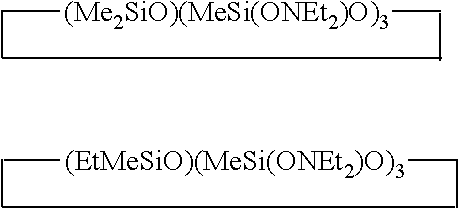Oil-In-Water Silicone Emulsion Composition
a silicone emulsion and oil-in-water technology, applied in the direction of mixing, transportation and packaging, coatings, etc., can solve the problems of large amounts of siloxane oligomers, insufficient strength of cured films, and insufficient adhesion to substrates by cured films, etc., to achieve satisfactory adherence to substrates, satisfactory rubbery elasticity, and satisfactory strength
- Summary
- Abstract
- Description
- Claims
- Application Information
AI Technical Summary
Benefits of technology
Problems solved by technology
Method used
Image
Examples
example 1
[0060]50.0 parts of a polydimethylsiloxane endblocked at both molecular chain terminals by the hydroxydimethylsiloxy group and having a viscosity of 2,400 mPa·s, 2.0 parts of the aminoxy group-containing polysiloxane given by formula (1) below, and 1.0 part tetraethoxysilane were mixed:
Me3SiO(Me2SiO)1(MeSi(ONEt2)O)3SiMe3 (1)
This was followed by the addition of 3.0 parts water and 8.0 parts of a 70% aqueous solution of sodium polyoxyethylene (2 mol) lauryl ether sulfate and mixing and then emulsification using a continuous mixing apparatus. After dilution with 1.5 parts water and 33.0 parts colloidal silica (trade name: Snowtex C, from Nissan Chemical Industries, Ltd., effective component=20%), 1.5 parts of an aqueous solution provided by diluting 0.5 part diethylamine as a pH adjusting agent with 1.0 part water was added, thus producing an oil-in-water silicone emulsion. The average particle size of the obtained emulsion particles was 320 nm; the siloxane oligomers comprising 4 to ...
example 2
[0061]An emulsion was prepared as in Example 1, but in this case using 2.0 parts of the aminoxy group-containing polysiloxane given by formula (2) below rather than the 2.0 parts of the aminoxy group-containing polysiloxane given by formula (1) above and used in Example 1, and using 5.0 parts of an 85% aqueous solution of polyoxyethylene (7 mol) branched decyl ether as the emulsifying agent rather than the 8.0 parts 70% aqueous sodium polyoxyethylene (2 mol) lauryl ether sulfate solution.
Me3SiO(Me2SiO)3(MeSi(ONEt2)O)5SiMe3 (2)
[0062]The average particle size of the obtained emulsion particles was 360 nm; the siloxane oligomers comprising 4 to 5 siloxane units were octamethyltetracyclosiloxane and decamethylpentacyclosiloxane; and their content was 0.12%. Three days after its preparation, the obtained emulsion composition was coated on a glass panel and the status of the cured film was evaluated: a cured film having a satisfactory adherence and elasticity was obtained, but some plast...
example 3
[0063]An emulsion was prepared as in Example 1, but in this case using 2.0 parts of the aminoxy group-containing polysiloxane given by formula (2) above and used in Example 2 rather than the 2.0 parts of the aminoxy group-containing polysiloxane given by formula (1) above and used in Example 1, changing the water used for dilution from 1.5 parts to 18.0 parts, and changing the quantity of colloidal silica (trade name: Snowtex C, from Nissan Chemical Industries, Ltd., effective component=20%) from 33.0 parts to 16.5 parts. The average particle size of the obtained emulsion particles was 290 nm; the siloxane oligomers comprising 4 to 5 siloxane units were octamethyltetracyclosiloxane and decamethylpentacyclosiloxane; and their content was 0.12%. One day after its preparation, the obtained emulsion composition was coated on a glass panel and the status of the cured film was evaluated: a cured film having a satisfactory adherence and rubbery elasticity was obtained, while plastic deform...
PUM
| Property | Measurement | Unit |
|---|---|---|
| viscosity | aaaaa | aaaaa |
| particle size | aaaaa | aaaaa |
| viscosity | aaaaa | aaaaa |
Abstract
Description
Claims
Application Information
 Login to View More
Login to View More - R&D
- Intellectual Property
- Life Sciences
- Materials
- Tech Scout
- Unparalleled Data Quality
- Higher Quality Content
- 60% Fewer Hallucinations
Browse by: Latest US Patents, China's latest patents, Technical Efficacy Thesaurus, Application Domain, Technology Topic, Popular Technical Reports.
© 2025 PatSnap. All rights reserved.Legal|Privacy policy|Modern Slavery Act Transparency Statement|Sitemap|About US| Contact US: help@patsnap.com

